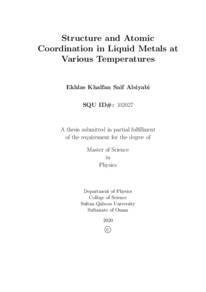وثيقة
Structure and atomic coordination in liquid metals at various temperatures.
الناشر
Sultan Qaboos University.
ميلادي
2020
اللغة
الأنجليزية
الموضوع
الملخص الإنجليزي
At certain temperatures, all metallic systems and their alloys melt
from the solid state to liquid state – this transition temperature is
known as the melting temperature of the corresponding system. This
is simultaneously a critical and important phenomenon for all materials from metallurgical point of view. At this critical temperature, the
structure of the system changes drastically from an ordered state to a
disordered state. It is reiterated here that at the solid crystalline state
of a metal, the atoms constitute a regular array maintaining both the
short range and long range orders. However, after the melting temperature, the system retains only the short range order; the long range
order smears out because of the breaking of the crystalline symmetry. In the vicinity of the melting, the system temporarily undergoes
multi-phase transformations immediately before it goes to a homogeneous random state. At this state, the system becomes a homogeneous
liquid. In the liquid state, structurally the system is characterized by
two important functions, namely, the pair distribution function g(r)
and the structure factor S(Q) – the latter being the Fourier transform
of the earlier.
In this project, we have initially investigated the temperature dependence of g(r) and S(Q) for 11 liquid metals: Sodium Na, Potassium
K, Cesium Cs, Rubidium Rb, Zinc Zn, Cadmium Cd, Mercury Hg,
Aluminum Al, Gallium Ga, Silicon Si and Germanium Ge, taken from
different groups in the periodic table, at different temperatures. These
were then followed by calculating the coordination numbers N i for
v
these systems at various temperatures. We have undertaken 3 methods in our project. Our plan follows the scheme:
1. Extraction of analytically patterns of g(r) and S(Q) from experiments: In this part, we extracted the graphical representation of g(r)
and S(Q) from the results obtained from diffraction experiments of a
number of metallic systems. This demonstrates the structural information of the systems in the vicinity of melting and beyond.
2. Theoretical deductions of g(r) and S(Q) : We have then theoretically deduced g(r) and S(Q) from the established equations of states.
At this stage, temperature dependence of these functions has been
precisely taken care of while calculating g(r) and S(Q) at various
temperatures. These are found to be comparable to the experimental
results just briefed.
3. Monte Carlo Simulation in calculating g(r) and S(Q): Our next effort was to compute g(r) and S(Q) by using the Monte Carlo Method
of simulation at various temperatures. The results are observed to
follow consistently both the experimental and theoretical trends.
4. Calculations of coordination numbers: Concurrently, we have calculated the coordination numbers (first, second and third) for 11 liquid metals mentioned earlier by using the experimentally extracted,
theoretically calculated and simulated values for g(r), at various temperatures.
The results for coordination numbers, Ni are found to be consistent
with one another of the three methods undertaken. These values are
observed to follow, to extent, a trend similar to their solid state counter
parts.
المجموعة
URL المصدر
قالب العنصر
الرسائل والأطروحات الجامعية

